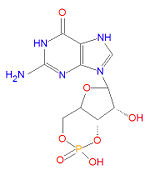Sildenafil: Difference between revisions
imported>David E. Volk (→Mechanism of action: picture of cGMP) |
imported>David E. Volk |
||
| Line 24: | Line 24: | ||
== Drug interactions == | == Drug interactions == | ||
Because sildenafil has vasodilator properties that result in decreased blood pressure, the combined use of sildenafil with other vasodilators, such as [[alpha-blocker]]s, must be done cautiously. Patients with a history of [[myocardial infarction|heart attack]]s, [[stroke]]s, [[arrythmia]], [[hypertension]], [[retinitis pigmentosa]] or currently on [[bosentan therapy]]. | Because sildenafil has vasodilator properties that result in decreased blood pressure, the combined use of sildenafil with other vasodilators, such as [[alpha-blocker]]s, must be done cautiously. Patients with a history of [[myocardial infarction|heart attack]]s, [[stroke]]s, [[arrythmia]], [[hypertension]], [[retinitis pigmentosa]] or currently on [[bosentan therapy]] should also be cautious. | ||
== Up-to-Date Information== | == Up-to-Date Information== | ||
Revision as of 16:11, 21 June 2008
|
| |||||||
| sildenafil | |||||||
| |||||||
| Uses: | Erectile Dysfunction | ||||||
| Properties: | PDE-5 inhibitor | ||||||
| Hazards: | cardiovascular risks | ||||||
| |||||||
Sildenafil, widely known as Viagra®, is a medication used to treat erectile dysfunction. It is also marketed as Ravatio® as an oral treatment for pulmonary arterial hypertension. Both drugs are sold as the citrate salt of sildenafil. It was the first commercialized selective phosphodiesterase type 5 (PDE-5) inhibitor and was immediately popular both for treating erectile dysfunction and for recreational use. Sildenafil works by binding to phosphodiesterase type-5 enzymes, competing with the natural ligand cyclic guanine monophosphate (cGMP), which is structurally similar to sildenafil. Vardenafil, a newer and more potent PDE-5 inhibitor, is nearly identical to sildenafil, while tadalafil is considerably different in structure.
Mechanism of action
By competitively binding to PDE-5 enzymes in smooth muscle and therefore inhibiting the binding of cGMP to PDE-5, the degradation of cGMP is reduced resulting in elevated levels of cGMP in the corpus cavernosum and its supply vessels. The elevated cGMP levels relax the smooth muscles, dilate the corporeal sinusoids and increase blood flow enabling an erection. cGMP levels are normally increased during stimulation by the release of nitric oxide in the corpus cavernosum. The nitric oxide activates guanylate cyclase, an enyme, which produces cGMP. Thus, sildenafil does not enhance the normal mechanism, namely increased synthesis of cGMP, but rather reduces its degradation.
Chemistry
The IUPAC name of sildenafil is 1-[[3-(6,7-dihydro-1-methyl-7-oxo-3-propyl-1H-pyrazolo [4,3-d] pyrimidin-5-yl)-4-ethoxyphenyl] sulfonyl]-4-methylpiperazine and it has a molecular mass of 666.7 g/mol (as the citrate salt).
Drug interactions
Because sildenafil has vasodilator properties that result in decreased blood pressure, the combined use of sildenafil with other vasodilators, such as alpha-blockers, must be done cautiously. Patients with a history of heart attacks, strokes, arrythmia, hypertension, retinitis pigmentosa or currently on bosentan therapy should also be cautious.
Up-to-Date Information
The most up-to-date information about this and other drugs can be found at the following sites.
- Sildenafil - FDA approved drug information (drug label) from DailyMed (U.S. National Library of Medicine).
References
J. D. Corbin and S. H. Sharron. "Molecular Biology and Pharmacology of PDE-5-Inhibitor Therapy for Erectile Dysfunction". J. Androl. 24: S38-S41.

